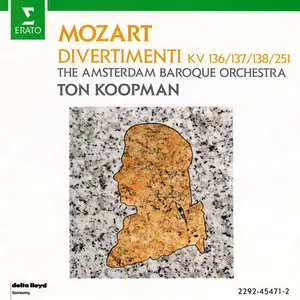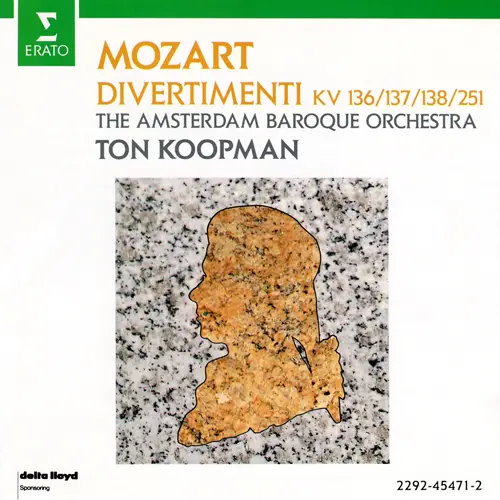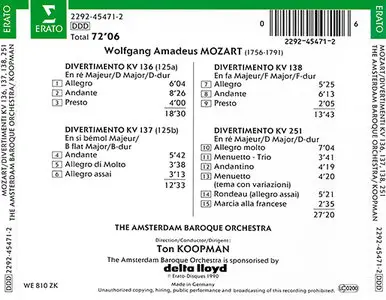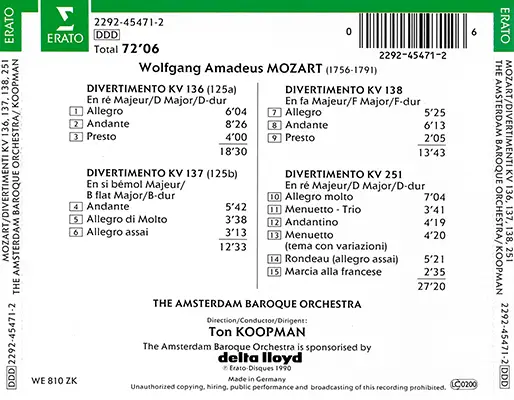Wolfgang Amadeus Mozart - Divertimenti KV 136-138, 251
The Amsterdam Baroque Orchestra / Ton Koopman
EAC+LOG+CUE | FLAC: 331 MB | Artwork | 5% Recovery Info
Label/Cat#: Erato # 2292-45471-2 | Country/Year: rance 1990
Genre: Classical | Style: Viennese School
MD5 [X] CUE [X] LOG [X] INFO TEXT [X] ARTWORK [X]
my rip [] not my rip [X]
Exact Audio Copy V0.99 prebeta 5 from 4. May 2009
EAC extraction logfile from 27. January 2012, 13:16
Wolfgang Amadeus Mozart / Divertimenti
Used drive : Optiarc DVD RW AD-7243S Adapter: 6 ID: 0
Read mode : Secure
Utilize accurate stream : Yes
Defeat audio cache : Yes
Make use of C2 pointers : No
Read offset correction : 48
Overread into Lead-In and Lead-Out : No
Fill up missing offset samples with silence : Yes
Delete leading and trailing silent blocks : No
Null samples used in CRC calculations : Yes
Used interface : Native Win32 interface for Win NT & 2000
Used output format : User Defined Encoder
Selected bitrate : 768 kBit/s
Quality : High
Add ID3 tag : No
Command line compressor : D:\Program Files\Exact Audio Copy\FLAC\FLAC.EXE
Additional command line options : -6 -V -T "ARTIST=%a" -T "TITLE=%t" -T "ALBUM=%g" -T "DATE=%y" -T "TRACKNUMBER=%n" -T "GENRE=%m" -T "COMMENT=%e" %s -o %d
TOC of the extracted CD
Track | Start | Length | Start sector | End sector
––––––––––––––––––––––––––––-
1 | 0:00.00 | 6:07.20 | 0 | 27544
2 | 6:07.20 | 8:24.65 | 27545 | 65409
3 | 14:32.10 | 4:08.45 | 65410 | 84054
4 | 18:40.55 | 5:34.13 | 84055 | 109117
5 | 24:14.68 | 3:38.57 | 109118 | 125524
6 | 27:53.50 | 3:19.03 | 125525 | 140452
7 | 31:12.53 | 5:18.25 | 140453 | 164327
8 | 36:31.03 | 6:12.55 | 164328 | 192282
9 | 42:43.58 | 2:12.70 | 192283 | 202252
10 | 44:56.53 | 6:56.10 | 202253 | 233462
11 | 51:52.63 | 3:41.32 | 233463 | 250069
12 | 55:34.20 | 4:18.00 | 250070 | 269419
13 | 59:52.20 | 4:20.35 | 269420 | 288954
14 | 64:12.55 | 5:21.70 | 288955 | 313099
15 | 69:34.50 | 2:32.33 | 313100 | 324532
Range status and errors
Selected range
Filename E:\CDImage.wav
Peak level 100.0 %
Range quality 99.9 %
Test CRC 2AB3979F
Copy CRC 2AB3979F
Copy OK
No errors occurred
AccurateRip summary
Track 1 accurately ripped (confidence 6) [F769BFB0]
Track 2 accurately ripped (confidence 6) [0313DC86]
Track 3 accurately ripped (confidence 6) [4D339307]
Track 4 accurately ripped (confidence 6) [5C90FE9C]
Track 5 accurately ripped (confidence 6) [BB2372F9]
Track 6 accurately ripped (confidence 6) [FED156FB]
Track 7 accurately ripped (confidence 5) [29653CF5]
Track 8 accurately ripped (confidence 6) [C60C14A6]
Track 9 accurately ripped (confidence 6) [DFFD7358]
Track 10 accurately ripped (confidence 6) [FF8561C6]
Track 11 accurately ripped (confidence 6) [BFCD57C5]
Track 12 accurately ripped (confidence 6) [E9E9B983]
Track 13 accurately ripped (confidence 5) [8EC8FBB0]
Track 14 accurately ripped (confidence 5) [D297AA80]
Track 15 accurately ripped (confidence 6) [C980265D]
All tracks accurately ripped
End of status report
EAC extraction logfile from 27. January 2012, 13:16
Wolfgang Amadeus Mozart / Divertimenti
Used drive : Optiarc DVD RW AD-7243S Adapter: 6 ID: 0
Read mode : Secure
Utilize accurate stream : Yes
Defeat audio cache : Yes
Make use of C2 pointers : No
Read offset correction : 48
Overread into Lead-In and Lead-Out : No
Fill up missing offset samples with silence : Yes
Delete leading and trailing silent blocks : No
Null samples used in CRC calculations : Yes
Used interface : Native Win32 interface for Win NT & 2000
Used output format : User Defined Encoder
Selected bitrate : 768 kBit/s
Quality : High
Add ID3 tag : No
Command line compressor : D:\Program Files\Exact Audio Copy\FLAC\FLAC.EXE
Additional command line options : -6 -V -T "ARTIST=%a" -T "TITLE=%t" -T "ALBUM=%g" -T "DATE=%y" -T "TRACKNUMBER=%n" -T "GENRE=%m" -T "COMMENT=%e" %s -o %d
TOC of the extracted CD
Track | Start | Length | Start sector | End sector
––––––––––––––––––––––––––––-
1 | 0:00.00 | 6:07.20 | 0 | 27544
2 | 6:07.20 | 8:24.65 | 27545 | 65409
3 | 14:32.10 | 4:08.45 | 65410 | 84054
4 | 18:40.55 | 5:34.13 | 84055 | 109117
5 | 24:14.68 | 3:38.57 | 109118 | 125524
6 | 27:53.50 | 3:19.03 | 125525 | 140452
7 | 31:12.53 | 5:18.25 | 140453 | 164327
8 | 36:31.03 | 6:12.55 | 164328 | 192282
9 | 42:43.58 | 2:12.70 | 192283 | 202252
10 | 44:56.53 | 6:56.10 | 202253 | 233462
11 | 51:52.63 | 3:41.32 | 233463 | 250069
12 | 55:34.20 | 4:18.00 | 250070 | 269419
13 | 59:52.20 | 4:20.35 | 269420 | 288954
14 | 64:12.55 | 5:21.70 | 288955 | 313099
15 | 69:34.50 | 2:32.33 | 313100 | 324532
Range status and errors
Selected range
Filename E:\CDImage.wav
Peak level 100.0 %
Range quality 99.9 %
Test CRC 2AB3979F
Copy CRC 2AB3979F
Copy OK
No errors occurred
AccurateRip summary
Track 1 accurately ripped (confidence 6) [F769BFB0]
Track 2 accurately ripped (confidence 6) [0313DC86]
Track 3 accurately ripped (confidence 6) [4D339307]
Track 4 accurately ripped (confidence 6) [5C90FE9C]
Track 5 accurately ripped (confidence 6) [BB2372F9]
Track 6 accurately ripped (confidence 6) [FED156FB]
Track 7 accurately ripped (confidence 5) [29653CF5]
Track 8 accurately ripped (confidence 6) [C60C14A6]
Track 9 accurately ripped (confidence 6) [DFFD7358]
Track 10 accurately ripped (confidence 6) [FF8561C6]
Track 11 accurately ripped (confidence 6) [BFCD57C5]
Track 12 accurately ripped (confidence 6) [E9E9B983]
Track 13 accurately ripped (confidence 5) [8EC8FBB0]
Track 14 accurately ripped (confidence 5) [D297AA80]
Track 15 accurately ripped (confidence 6) [C980265D]
All tracks accurately ripped
End of status report
auCDtect: CD records authenticity detector, version 0.8.2
Copyright © 2004 Oleg Berngardt. All rights reserved.
Copyright © 2004 Alexander Djourik. All rights reserved.
Detect mode (0..40 with 0 = most accurate): 8 (default)
––––––––––––––––––––––––––––––
[CDImage.wav]
Detected average hi-boundary frequency: 2.030525e+004 Hz
Detected average lo-boundary frequency: 1.360236e+004 Hz
Detected average hi-cut frequency: 2.109778e+004 Hz
Detected average lo-cut frequency: 1.218590e+004 Hz
Maximum probablis boundary frequency: 2.189100e+004 Hz
Coefficient of nonlinearity of a phase: 8.027342e-001
First order smothness: 3.147826e-001
Second order smothness: 7.551691e-001
––––––––––––––––––––––––––––––
This track looks like CDDA with probability 100%.
Copyright © 2004 Oleg Berngardt. All rights reserved.
Copyright © 2004 Alexander Djourik. All rights reserved.
Detect mode (0..40 with 0 = most accurate): 8 (default)
––––––––––––––––––––––––––––––
[CDImage.wav]
Detected average hi-boundary frequency: 2.030525e+004 Hz
Detected average lo-boundary frequency: 1.360236e+004 Hz
Detected average hi-cut frequency: 2.109778e+004 Hz
Detected average lo-cut frequency: 1.218590e+004 Hz
Maximum probablis boundary frequency: 2.189100e+004 Hz
Coefficient of nonlinearity of a phase: 8.027342e-001
First order smothness: 3.147826e-001
Second order smothness: 7.551691e-001
––––––––––––––––––––––––––––––
This track looks like CDDA with probability 100%.
foobar2000 1.1.14a / Dynamic Range Meter 1.1.1
log date: 2014-06-16 13:08:26
––––––––––––––––––––––––––––––––––––––––
Analyzed: Wolfgang Amadeus Mozart / Divertimenti
––––––––––––––––––––––––––––––––––––––––
DR Peak RMS Duration Track
––––––––––––––––––––––––––––––––––––––––
DR15 -5.19 dB -22.76 dB 6:07 01-Divertimento D-dur KV 136 (125a): 1. Allegro
DR14 -6.73 dB -25.49 dB 8:25 02-Divertimento D-dur KV 136 (125a): 2. Andante
DR16 -3.16 dB -23.26 dB 4:09 03-Divertimento D-dur KV 136 (125a): 3. Presto
DR18 -2.99 dB -25.15 dB 5:34 04-Divertimento B-dur KV 137 (125b): 1. Andante
DR16 -0.51 dB -22.19 dB 3:39 05-Divertimento B-dur KV 137 (125b): 2. Allegro di molto
DR15 -4.32 dB -23.81 dB 3:19 06-Divertimento B-dur KV 137 (125b): 3. Allegro assai
DR15 -3.41 dB -22.95 dB 5:18 07-Divertimento F-dur KV 138 (125c): 1. Allegro
DR13 -5.95 dB -25.46 dB 6:13 08-Divertimento F-dur KV 138 (125c): 1. Andante
DR13 -5.81 dB -23.77 dB 2:13 09-Divertimento F-dur KV 138 (125c): 3. Presto
DR13 0.00 dB -17.91 dB 6:56 10-Divertimento D-dur KV 251: 1. Allegro molto
DR13 -0.43 dB -19.76 dB 3:41 11-Divertimento D-dur KV 251: 2. Menuetto - Trio
DR12 -5.59 dB -22.79 dB 4:18 12-Divertimento D-dur KV 251: 3. Andantino
DR14 -2.20 dB -21.46 dB 4:20 13-Divertimento D-dur KV 251: 4. Menuetto. Tema con variazioni
DR13 -1.67 dB -19.85 dB 5:22 14-Divertimento D-dur KV 251: 5. Rondeau. Allegro assai
DR13 0.00 dB -17.56 dB 2:32 15-Divertimento D-dur KV 251: 6. Marcia alla francese
––––––––––––––––––––––––––––––––––––––––
Number of tracks: 15
Official DR value: DR14
Samplerate: 44100 Hz
Channels: 2
Bits per sample: 16
Bitrate: 611 kbps
Codec: FLAC
================================================================================
log date: 2014-06-16 13:08:26
––––––––––––––––––––––––––––––––––––––––
Analyzed: Wolfgang Amadeus Mozart / Divertimenti
––––––––––––––––––––––––––––––––––––––––
DR Peak RMS Duration Track
––––––––––––––––––––––––––––––––––––––––
DR15 -5.19 dB -22.76 dB 6:07 01-Divertimento D-dur KV 136 (125a): 1. Allegro
DR14 -6.73 dB -25.49 dB 8:25 02-Divertimento D-dur KV 136 (125a): 2. Andante
DR16 -3.16 dB -23.26 dB 4:09 03-Divertimento D-dur KV 136 (125a): 3. Presto
DR18 -2.99 dB -25.15 dB 5:34 04-Divertimento B-dur KV 137 (125b): 1. Andante
DR16 -0.51 dB -22.19 dB 3:39 05-Divertimento B-dur KV 137 (125b): 2. Allegro di molto
DR15 -4.32 dB -23.81 dB 3:19 06-Divertimento B-dur KV 137 (125b): 3. Allegro assai
DR15 -3.41 dB -22.95 dB 5:18 07-Divertimento F-dur KV 138 (125c): 1. Allegro
DR13 -5.95 dB -25.46 dB 6:13 08-Divertimento F-dur KV 138 (125c): 1. Andante
DR13 -5.81 dB -23.77 dB 2:13 09-Divertimento F-dur KV 138 (125c): 3. Presto
DR13 0.00 dB -17.91 dB 6:56 10-Divertimento D-dur KV 251: 1. Allegro molto
DR13 -0.43 dB -19.76 dB 3:41 11-Divertimento D-dur KV 251: 2. Menuetto - Trio
DR12 -5.59 dB -22.79 dB 4:18 12-Divertimento D-dur KV 251: 3. Andantino
DR14 -2.20 dB -21.46 dB 4:20 13-Divertimento D-dur KV 251: 4. Menuetto. Tema con variazioni
DR13 -1.67 dB -19.85 dB 5:22 14-Divertimento D-dur KV 251: 5. Rondeau. Allegro assai
DR13 0.00 dB -17.56 dB 2:32 15-Divertimento D-dur KV 251: 6. Marcia alla francese
––––––––––––––––––––––––––––––––––––––––
Number of tracks: 15
Official DR value: DR14
Samplerate: 44100 Hz
Channels: 2
Bits per sample: 16
Bitrate: 611 kbps
Codec: FLAC
================================================================================
CD Info:
Wolfgang Amadeus Mozart - Divertimenti KV 136-138, 251
The Amsterdam Baroque Orchestra / Ton Koopman
Label: Erato
Catalog#: 2292-45471-2
Format: CD, Album
Country: France
Released: 1990
Genre: Classical
Style: Viennese School
Tracklist:
Divertimento D-dur KV 136 (125a)
[01] 1. Allegro
[02] 2. Andante
[03] 3. Presto
Divertimento B-dur KV 137 (125b)
[04] 1. Andante
[05] 2. Allegro di molto
[06] 3. Allegro assai
Divertimento F-dur KV 138 (125c)
[07] 1. Allegro
[08] 1. Andante
[09] 3. Presto
Divertimento D-dur KV 251
[10] 1. Allegro molto
[11] 2. Menuetto - Trio
[12] 3. Andantino
[13] 4. Menuetto. Tema con variazioni
[14] 5. Rondeau. Allegro assai
[15] 6. Marcia alla francese
Pavlo Beznoziuk, Andrew Manze, Nicola Cleminson, Caroline Baiding,
Nicolette Moonen, Helen Orsler, Margareth Faultness, Mark Cooper, violins
Jan Schlapp, Jane Norman, violas
Jaap ter Linden, Ageet Zweistra, violoncelles
Nicholas Pap, double-bass
Marcel Ponseele, oboe
Michel Garcin Marrou, François Mérand, horns
Ton Koopman, conductor
Total time: 72'06
Recorded: 05/1989, Bartholomeuskerk Beek (Nijmegen), Pays-Bas
The terms serenade, nocturne, cassation and divertimento were used more or less interchangeably by Mozart and his contemporaries. All were taken to mean music of a lightweight, entertaining nature, suitable for use at social functions. Mozart, however, considerably broadened the expectations of what such works might consist of, composing masterpieces like the Serenade for 13 wind instruments, K.375, or the late great Divertimento in Bb for string trio.
In any case, if we could time-travel back to the 18th century, I think we might be surprised just how much attention was paid to so-called background music. Nowadays, at functions where there is live music at a party or reception, the tendency is for guests to shout loudly above it, and it’s regarded as slightly bad form to show the slightest interest! In Mozart’s day, the music would be a major source of comment and discussion, just like the food and drink, the company and so forth.
Hence these slight works are charming and impeccably crafted. Yes, they are mostly the sort of stuff Mozart could compose in his sleep (almost literally), but they still have the capacity to surprise and delight. The first three on this disc are all genuinely early pieces, scored for strings alone, while the fourth one is from a little later, and includes parts for an oboe and two horns.
There is a freshness about K.136 in D that is like biting into a crisp green apple. The central Andante has an easy lyricism that is profoundly relaxing, while the finale is full of effervescent humour. K.137 is not so attractive, but is extremely interesting in stylistic terms. An awful lot of fuss is always made of the opening chord of Beethoven’s first symphony, whose first chord immediately points away from the tonic key, C major. Well, Beethoven was 29 when he composed that symphony in 1799; here is the 16-year-old Mozart starting a piece in Bb major, with no preamble, by going straight to C minor, and then on to D minor, before settling in the home key – and this twenty-seven years before the Beethoven - Ludwig, eat your heart out! I have no doubt that a few eyebrows were raised when this divertimento was first played.
The rest of K.137 is more mundane, as is K.138 in F, though its first movement is charming, and contains a little thematic ‘pre-echo’ of the equivalent movement in Eine Kleine Nachtmusik (Track 7, 0:53]. The slow movement finds the young composer experimenting with the considerable expressive possibilities of dissonance, and doing it to great effect.
The playing of the Amsterdam Baroque Orchestra in all of these pieces is a delight. Clean as a whistle, impeccably stylish, yet with none of that impoverished tone we sometimes get in ‘period’ performances. It’s full of character, with many tiny points of contrast and detail brought out clearly without distorting the texture. Koopman doesn’t get in the way, just allows his excellent strings to get on with it – hence the music flows naturally.
I confess I like the K.251 Divertimento much less than the earlier three. It is attractive enough, but seems very routine and rather humourless. The general feeling of monotony is not helped by the scarcity of modulation; five out of the six movements are firmly rooted in D, and excursions to anything other than the most closely related keys are few and far between. This is particularly noticeable in the tedious Rondeau fifth movement and its successor, the inconsequential little Marcia aale francese. (Is there a touch of Mozartian humour in the use of French for ‘Rondeau’ instead of the more normal ‘Rondo’, then the use of Italian for the last movement, whose title means ‘March in French style’?! I think so.) The whole piece is about as inspiration-free as Mozart could get; which, annoyingly, means that it’s still pretty terrific for this genre of piece in this era by a 20-year-old. I’m judging it by Mozart’s own standards.
Koopman opts for solo strings in this, which is generally a good idea, and allows the two horns and oboe to sing out easily. Some listeners, however, may find the solo double-bass just a little too prominent – it has a quite percussive edge sometimes, which is not at all unpleasant, but a touch surprising nonetheless. (No slur on the excellent bass playing, more likely a problem for the recording team).
This is an ideal issue for these hot summer nights; Eine Kleine Mozart to keep you cool with highly efficient musical air-conditioning.
Gwyn Parry-Jones, MusicWeb International
Thanks to aqr!







